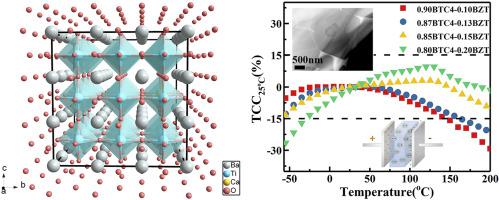Journal of Materiomics ( IF 8.4 ) Pub Date : 2020-09-09 , DOI: 10.1016/j.jmat.2020.09.001 Xuewen Jiang , Hua Hao , Yang Yang , Enhao Zhou , Shujun Zhang , Ping Wei , Minghe Cao , Zhonghua Yao , Hanxing Liu

|
Capacitor is an important part of many electronic devices, so the temperature stability as one key parameter of capacitor needs to be improved constantly for meeting the requirements of various application temperature. Here, combined with the X-ray diffraction (XRD), selected area electron diffraction (SAED) and Vienna Ab-initio Simulation Package (VASP) calculation, it was confirmed that Ca ion can substitute the Ti site in the BaTi1-xCaxO3-x [BTC100×] (0 ≤ x ≤ 0.05) ceramics synthesized by solid-phase method which greatly improved the low-temperature stability of dielectric constant. Moreover, introducing Bi3+ and Zn2+ into BTC4 to form (1-y)BaTi0·96Ca0·04O2.96-yBi(Zn0·5Ti0.5)O3 [(1-y)BTC4-yBZT] (0.1 ≤ y ≤ 0.2) ceramics can further improve the dielectric-temperature stability by means of diffused phase transition and core-shell structure. Most importantly, the 0.85BTC4-0.15BZT ceramics with a pseudocubic perovskite structure possessed a temperature coefficient of capacitance at 25 °C () being less than ±15% over a wide temperature range of −55 °C–200 °C and a temperate dielectric constant (ε = 1060) and low dielectric loss (tanδ = 1.5%), which measure up to the higher standard in the current capacitor industry such as X9R requirements.
中文翻译:

Ca离子B位点掺杂对BaTiO 3基陶瓷的结构和增强的介电温度稳定性
电容器是许多电子设备的重要组成部分,因此温度稳定性作为电容器的一个关键参数,需要不断提高以适应各种应用温度的要求。在此,结合X射线衍射(XRD),选择区域电子衍射(SAED)和Vienna Ab-initio模拟程序包(VASP)计算,证实了Ca离子可以替代BaTi 1-x Ca中的Ti位置。通过固相法合成的x O 3-x [BTC100×](0≤x≤0.05)陶瓷极大地提高了介电常数的低温稳定性。此外,将Bi 3+和Zn 2+引入BTC4形成(1-y)BaTi 0·96 Ca 0·04O 2.96 -yBi(Zn 0·5 Ti 0.5)O 3 [(1-y)BTC4-yBZT](0.1≤y≤0.2)陶瓷可以通过扩散相变和核-壳层进一步提高介电温度稳定性结构体。最重要的是,具有伪立方钙钛矿结构的0.85BTC4-0.15BZT陶瓷在25°C()在-55°C–200°C的宽温度范围内具有小于±15%的温度,并且具有温和的介电常数(ε= 1060)和低的介电损耗(tanδ= 1.5%),可以测量到更高的标准当前诸如X9R的电容器行业要求。











































 京公网安备 11010802027423号
京公网安备 11010802027423号